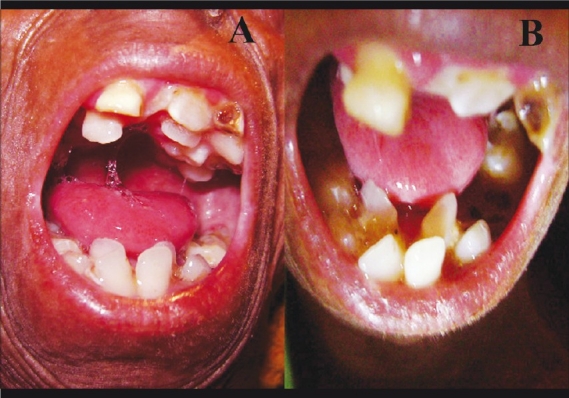Progeria physical examination
Jump to navigation
Jump to search
|
Progeria Microchapters |
|
Diagnosis |
|---|
|
Treatment |
|
Case Studies |
|
Progeria physical examination On the Web |
|
American Roentgen Ray Society Images of Progeria physical examination |
|
Risk calculators and risk factors for Progeria physical examination |
Editor-In-Chief: C. Michael Gibson, M.S., M.D. [1]; Associate Editor(s)-in-Chief: Vamsikrishna Gunnam M.B.B.S [2]
Overview
Common physical examination findings of Hutchinson-Gilford progeria syndrome (HGPS) include skin changes, hair changes, eye problems and musculoskeletal abnormalities.
Physical Examination
Appearance of the Patient
- Patients with Hutchinson-Gilford progeria syndrome (HGPS) usually appear normal at birth.[1]
- Onset of symptoms usally occurs around 6-12 months in patients with Hutchinson-Gilford progeria syndrome (HGPS).
Vital Signs
- High blood pressure with normal pulse pressure.[2]
Skin
- Skin examination of patients with Hutchinson-Gilford progeria syndrome (HGPS) shows the following:[3][4][5]
- Skin atrophy
- Skin dryness
- Focal sclerotic and areas of laxity and outpouching of the skin
- Rigid and tense skin with erosions
- Intermittent hyperpigmentation along with hypopigmentation on the skin
- Patients have indurated, shiny, inelastic skin
- Aged-appearing skin due to the following:
- Loss of subcutaneous fat(most commonly on the hands and feet)
HEENT
- Abnormalities of the hair may include
- Hair loss
- Baldness
- progressive eyelashes loss
- Facial features are very characteristic in patients with Hutchinson-Gilford progeria syndrome (HGPS) which include:[6][7][8]
- Circumoral cyanosis with Thin lips
- Mouth in O position
- Prominent scalp veins
- Prominent eyes
- Fixed facial expressions
- Beaked nose
- pseudo hydrocephalus
- Micrognathia(undersized jaw)
- Retrognathia(abnormal posterior positioning of the maxilla or mandible)
- Protruding ears with absent lobes
- Frontal and parietal bossing
- Large anterior fontanel
- Possible exposure keratopathy
- Nocturnal lagophthalmos can be noticed in some patients with Hutchinson-Gilford progeria syndrome (HGPS)
- Blepharophimosis[9]
- Eruption of secondary incisors lingually and palatally in the mandible and maxillary area is noticed in patients with HGPS[10]
- Dental crowding and dental caries


Neck
- Neck examination of patients with Hutchinson-Gilford progeria syndrome (HGPS) is usually normal.
Lungs
- Pulmonary examination of patients with Hutchinson-Gilford progeria syndrome (HGPS) is usually normal.
Heart
- Cardiovascular examination of patients with Hutchinson-Gilford progeria syndrome (HGPS) is usually shows dextrocardia.
Abdomen
- Abdominal examination of patients with Hutchinson-Gilford progeria syndrome (HGPS) is usually normal.
Back
- Back examination of patients with Hutchinson-Gilford progeria syndrome (HGPS) is usually normal.
Genitourinary
- Genitourinary examination of patients with Hutchinson-Gilford progeria syndrome (HGPS) is usually normal.
Neuromuscular
- Neuromuscular examination of patients with Hutchinson-Gilford progeria syndrome (HGPS) is usually normal.
Extremities
- Musculoskeletal abnormalities which include:[13][14][15]
- Thin limbs with prominent joints
- Coxa valga
- Measured reductions in joint range of motion
- Osteoarthritis
- Joint contractures
- Pyriform (pear-shaped) thorax
- Bilateral hip dislocations
- Avascular necrosis of the femoral head
References
- ↑ Doubaj Y, Lamzouri A, Elalaoui SC, Laarabi FZ, Sefiani A (2011). "[Three cases of Hutchinson-Gilford progeria syndrome]". Arch Pediatr. 18 (2): 156–9. doi:10.1016/j.arcped.2010.11.014. PMID 21251803.
- ↑ Merideth MA, Gordon LB, Clauss S, Sachdev V, Smith AC, Perry MB; et al. (2008). "Phenotype and course of Hutchinson-Gilford progeria syndrome". N Engl J Med. 358 (6): 592–604. doi:10.1056/NEJMoa0706898. PMC 2940940. PMID 18256394.
- ↑ Adam MP, Ardinger HH, Pagon RA, Wallace SE, Bean LJH, Stephens K; et al. (1993). "GeneReviews®". PMID 20301300.
- ↑ Smitt JH, van Asperen CJ, Niessen CM, Beemer FA, van Essen AJ, Hulsmans RF; et al. (1998). "Restrictive dermopathy. Report of 12 cases. Dutch Task Force on Genodermatology". Arch Dermatol. 134 (5): 577–9. doi:10.1001/archderm.134.5.577. PMID 9606327.
- ↑ Merideth MA, Gordon LB, Clauss S, Sachdev V, Smith AC, Perry MB; et al. (2008). "Phenotype and course of Hutchinson-Gilford progeria syndrome". N Engl J Med. 358 (6): 592–604. doi:10.1056/NEJMoa0706898. PMC 2940940. PMID 18256394.
- ↑ Smitt JH, van Asperen CJ, Niessen CM, Beemer FA, van Essen AJ, Hulsmans RF; et al. (1998). "Restrictive dermopathy. Report of 12 cases. Dutch Task Force on Genodermatology". Arch Dermatol. 134 (5): 577–9. doi:10.1001/archderm.134.5.577. PMID 9606327.
- ↑ Ullrich NJ, Silvera VM, Campbell SE, Gordon LB (2012). "Craniofacial abnormalities in Hutchinson-Gilford progeria syndrome". AJNR Am J Neuroradiol. 33 (8): 1512–8. doi:10.3174/ajnr.A3088. PMID 22460337.
- ↑ Chandravanshi SL, Rawat AK, Dwivedi PC, Choudhary P (2011). "Ocular manifestations in the Hutchinson-Gilford progeria syndrome". Indian J Ophthalmol. 59 (6): 509–12. doi:10.4103/0301-4738.86327. PMC 3214428. PMID 22011502.
- ↑ Smitt JH, van Asperen CJ, Niessen CM, Beemer FA, van Essen AJ, Hulsmans RF; et al. (1998). "Restrictive dermopathy. Report of 12 cases. Dutch Task Force on Genodermatology". Arch Dermatol. 134 (5): 577–9. doi:10.1001/archderm.134.5.577. PMID 9606327.
- ↑ Gordon LB, McCarten KM, Giobbie-Hurder A, Machan JT, Campbell SE, Berns SD; et al. (2007). "Disease progression in Hutchinson-Gilford progeria syndrome: impact on growth and development". Pediatrics. 120 (4): 824–33. doi:10.1542/peds.2007-1357. PMID 17908770.
- ↑ "Ocular manifestations in the Hutchinson-Gilford progeria syndrome".
- ↑ "Ocular manifestations in the Hutchinson-Gilford progeria syndrome".
- ↑ Merideth MA, Gordon LB, Clauss S, Sachdev V, Smith AC, Perry MB et al. (2008) Phenotype and course of Hutchinson-Gilford progeria syndrome. N Engl J Med 358 (6):592-604. DOI:10.1056/NEJMoa0706898 PMID: 18256394
- ↑ Smitt JH, van Asperen CJ, Niessen CM, Beemer FA, van Essen AJ, Hulsmans RF; et al. (1998). "Restrictive dermopathy. Report of 12 cases. Dutch Task Force on Genodermatology". Arch Dermatol. 134 (5): 577–9. doi:10.1001/archderm.134.5.577. PMID 9606327.
- ↑ Gordon LB, McCarten KM, Giobbie-Hurder A, Machan JT, Campbell SE, Berns SD; et al. (2007). "Disease progression in Hutchinson-Gilford progeria syndrome: impact on growth and development". Pediatrics. 120 (4): 824–33. doi:10.1542/peds.2007-1357. PMID 17908770.